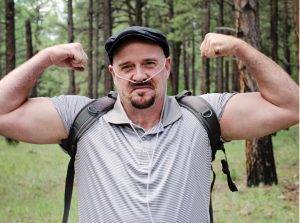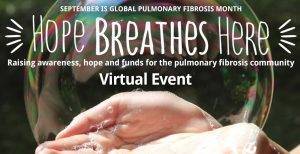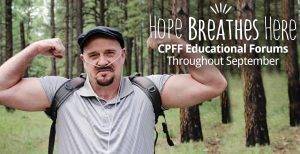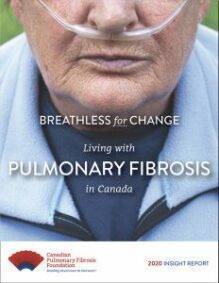We may be vulnerable, but we are also strong
By Sharon Lee, Executive Director, CPFF

As Canada’s largest cities and smaller towns enter stage three of re-opening during a pandemic, we are all feeling anxious about what lies ahead as we continue to adjust to life with COVID-19. So much is still unknown about the coronavirus, but we do know that people with pulmonary fibrosis are some of the most vulnerable Canadians.
We also know that people living with PF, as well as their families and friends, are also some of the strongest Canadians. We already know how to reduce our risk of catching a virus: wear a mask, wash our hands constantly, and maintain physical distance. We have also acquired the strength to ask for help when we need it.
There have also been benefits to life with COVID-19. Family, friends, neighbours and colleagues are reaching out to support those most vulnerable; from doing the groceries and picking up medications, to friendly calls to check in and health care professionals who are making access to treatment as safe as possible. Ordinary people offering simple assistance with extraordinary impact.
As a strong and vulnerable member of your community, you have a lot to teach the world about supporting one another and doing your part to keep everyone safe. And about making informed decisions and taking action to maintain your own health.
I hope you will join the Canadian Pulmonary Fibrosis Foundation (CPFF) during the month of September to raise awareness, hope and funds. We have created a virtual platform for you to share your stories, to participate in educational forums, and to join the Clarke family in walking virtually across Canada. We’ve also created a Virtual Bubble event that the whole family can enjoy from anywhere.
I encourage you to read the next article and then visit www.hopebreatheshere.com to register for our Pulmonary Fibrosis Awareness Month events and activities. If you find using the technology a bit daunting, please reach out to your network of family, friends and CPFF support group members to help you out. Remember, you are not alone, and the new website offers fun and informative activities to share with your friends and family, as well as those living with PF.
We are asking you to share your strength and your vulnerability this September with the wider world. Please reach out to your community and share your challenges and ask for their support. Visit www.hopebreatheshere.com and register today.
Register NOW for fun, informative and safe activities during Awareness Month

Despite the pandemic, Pulmonary Fibrosis Awareness Month this September may be our best ever. With most events and activities safely online, what’s on offer will help you and your family, friends and colleagues connect and spread the word about PF to the rest of the country in fun and engaging ways. There are also educational sessions online to help you live your best life with PF. And there are ample opportunities to share your stories, photos and videos.
Visit www.hopebreatheshere.com, CPFF’s website for Pulmonary Fibrosis Awareness Month to register for anything or everything (you choose) that’s on offer and more details about each event and activity. Here’s a quick rundown of what’s happening:

Clarke Walk for Pulmonary Fibrosis
Join the Clarke family and fellow Canadians as we walk to help CPFF raise awareness and funds for a pulmonary fibrosis cure. Walk on your own or with a team throughout September, and let’s see how many kilometers we can collectively walk from coast-to-coast. Find out more about the how the Clark walk started, and how you and your family, friends and neighbours can register, here.

Virtual Bubbles Event
Join neighbours across Canada on Labour Day Monday for an exciting virtual bubbles experience in augmented reality, from your home, yard, balcony or anywhere else. Visit www.hopebreatheshere.com/pulmonary-fibrosis-events/ to download the app you need onto your mobile phone or tablet and join the September 7 Labour Day virtual event to experience virtual bubbles. Presented at 7 p.m., it’s a magical event scheduled so that the whole family can enjoy it.

CPFF Educational Forums
Participate in informative CPFF educational sessions about pulmonary fibrosis, through virtual video sessions during the month of September. Get expert insights and support from medical and healthcare professionals, and connect with other PF patients and caregivers across Canada. A diverse line up of healthcare experts will share the latest pulmonary fibrosis (PF) research, insights on disease management, the impact of COVID-19 on PF, advance care planning, palliative care, and more. Video sessions will take place through the CPFF Event Portal and are easy to access from anywhere with an internet connection. Access sessions as they happen in any province, from the comfort of your home. Visit www.hopebreatheshere.com/cpff-educational-forums/ to learn more, access the CPFF Event Portal and register.

Hope Breathes Here Wrap-up & Applause
Join your neighbours across Canada as we come together on October 3 at 1 p.m. (EDT) to watch a slide show of memorable Hope Breathes Here event moments and celebrate a month of learning, friendship, and fundraising. Use the hashtag #hopebreatheshere in your Facebook or Twitter posts to be featured on our home page and in our closing slideshow.
In addition to the events listed above, hopebreatheshere.com offers speaker bios, researcher videos, back stories, and opportunities to share your personal story, photos and videos, and so much more.
As in years past, we are asking elected officials to proclaim September as Pulmonary Fibrosis Month. New this year, we’ll be asking them to videotape the proclamation, so we can post it on hopebreatheshere.com and on our social media channels.
And, CPFF is once again asking its supporters to request the lighting of community landmarks in September to promote Pulmonary Fibrosis Awareness Month. Sports facilities, clock towers and town halls are often able to be lit up for charitable purposes. We’ll post photos on our social media channels and on hopebreatheshere.com. If you take photos for Facebook, use the hashtag #hopebreatheshere and they’ll also appear on hopebreatheshere.com.
As in past years, we encourage you to take photos and videos of your own bubble blowing gatherings with family and friends (in accordance with physical distancing rules), and post them to Facebook using the hashtag #hopebreatheshere. It will then be shared on hopebreatheshere.com.
Everyone at CPFF is very excited about the opportunities we all have to connect, learn and have fun during Pulmonary Fibrosis Awareness Month this September. Please register now and get involved.

This spring we asked you to complete a survey about your experiences living with pulmonary fibrosis (PF), its impact on your life and what you need for your future. More than 640 people living with PF and their caregivers from across the country responded to our call. Thank you!
We are pleased to share with you the key survey results, as well as the Canadian Pulmonary Fibrosis Foundation’s (CPFF) Action Plan to address your concerns, in the report Breathless for Change. The survey results are presented in easy-to-understand bites of written information along with plenty of informative graphics and images.
Most of your responses are not a surprise. You told us it can take more than two years to be diagnosed. Your responses confirmed that access to treatment is inconsistent across the country and that reliable information and support is hard to find. You told us how this disease impacts you, your family and your community. And COVID-19 has only heightened your isolation, limited your access to support groups and increased stress levels for you and your family caregivers.
The following are just a sampling of the survey results you’ll find in the report:
- A vast majority of diagnoses are made by interstitial lung disease (ILD) respirologists, who are often difficult to access.
- There is unequal access to respirologists across the country.
- More than a third of patients do not feel their current treatment/routine is effective in managing their pulmonary fibrosis.
- Oxygen therapy is hard to access due to out-of-pocket costs in some provinces.
- 51 per cent of caregivers spend at least 2 hours per day caring for their family member and 11 per cent of caregivers spend more than six hours per day caring for their loved one.
- People living with PF and caregivers need help navigating the healthcare system and advocating for themselves.
- Two-thirds or people living with PF are not able to work or enjoy leisure activities or perform self-care activities as before.
- Sixty per cent of patients spend at least two hours per day caring for their pulmonary fibrosis.
Thanks to your participation in the survey, CPFF has the latest facts, figures and your testimonials to guide our direction and actions going forward and to share your collective experiences and needs with researchers, health care professionals, the media, the public and policymakers. We plan to highlight the survey’s findings and the report extensively during Pulmonary Fibrosis Awareness Month in September.
To address timely diagnosis, CPFF plans to increase our knowledge transfer activities to help more primary care physicians recognize the symptoms of PF and make the necessary referrals to ILD respirologists. We will continue to fund clinical research fellowships increasing the number of ILD specialists and research projects. This year, we are funding four such fellowships; twice as many as usual, thanks to one-time grants from Boehringer Ingelheim and Hoffmann-La Roche Ltd.
CPFF will keep working with governments to ensure equal access for all people living with pulmonary fibrosis (not only those living with IPF) to drug treatments, therapies and clinical trials. We will keep investing in research to deepen our understanding of pulmonary fibrosis, new treatments and an eventual cure.
We’ll be ramping up our resources and support for people living with PF and their caregivers. New publications and enhanced online channels will help our community stay informed and connected. We’ll raise the bar on public awareness to generate widespread support and help people experiencing symptoms to self-advocate.
We will never stop fighting for you. Because Breathing should never be hard work.©
Study looks at ways to determine progression in IPF

For the past three years, researchers in London, Ontario and Rome, Italy, have been investigating the relationship between disease progression determined by high resolution CT scan (HRCT) and functional decline in IPF. The study sought to confirm that a simple HRCT fibrosis visual score is a reliable predictor of mortality in IPF, when conducted regularly over time, and to determine which pulmonary function tests best reflect survival rates similar to the HRCT results.
The study involved 123 patients with IPF from two centres (about two-thirds in London, Ontario and one third in Rome, Italy), who were followed for an average of three years. Results were similar in patients from both centres.
“While the latest software using artificial intelligence (AI) may be applied in analyzing HRCT results, it is not readily available in most centres,” says respirologist Dr. Marco Mura, one of the study’s authors and director of the ILD clinic at London Health Sciences Centre. “With this study, we wanted to confirm that visual analysis of HRCT was still a reliable tool to assess progression in IPF.”
Each patient had two HRCTs and each HRCT was scored by two chest radiologists, to compare results between the two. In addition to HRCT scores, other lung function tests were conducted, including forced vital capacity (FVC) where a patient takes a deep breath and blows out as fast and hard as possible, as well as total lung capacity and lung capacity for carbon monoxide.
Overall, the study results were relatively as expected, says Dr. Mura. Patients showing an increase of more than seven per cent in lung fibrosis (scarring, honeycombing, etc.) over the study period, on average, had a higher chance of dying. During the three years, 43 patients died and 11 underwent a lung transplant. Both an HRCT showing a progression of fibrosis and a decline in FVC predicted survival independently and significantly.
Dr. Mura was reassured to see that the HRCT scores from the two different radiologists were quite consistent. “This leads us to believe that a visual examination of the HRCT is not as subjective as it could be,” says Dr. Mura, “reinforcing that HRCT is a fairly reliable tool.”
What do the results mean for patients and physicians? “It appears best to use both HRCT and FVC to assess disease progression in IPF,” explains Dr. Mura. “These are accessible and relatively affordable tools that can be used to make changes to treatment and refer patients to a transplant waiting list. However, concerningly, accuracy for predicting survival is still only at about 61 to 66 per cent using a combination of both measurements, meaning that we still need to do better, adding other affordable tools such the six-minute walk test to our evaluation.”
This study is one part of a broader investigation into ways to improve the determination of disease progression in IPF. Dr. Mura hopes to collaborate with other researchers in Canada and internationally, to study other tools that may contribute to a multi-dimensional disease assessment.
Published in May 2020, in Respiratory Research, the study was partially funded by the Canadian Pulmonary Fibrosis Foundation (CPFF). “I’m incredibly grateful to the donors of CPFF for their support,” says Dr. Mura. “CPFF’s contribution made it possible to pay the study’s clinical research assistant, who was fundamental in collecting the necessary data.”


